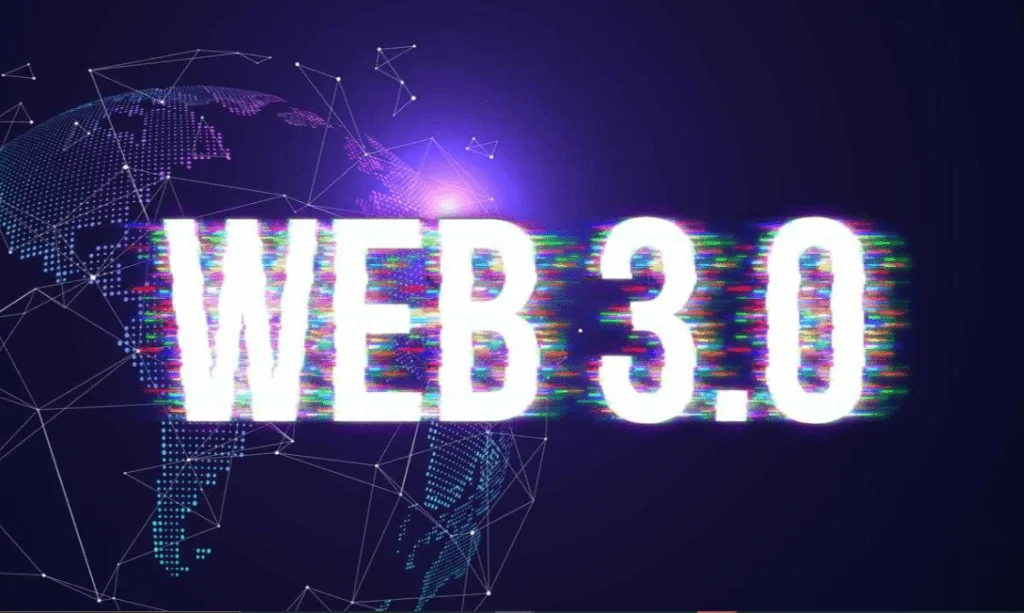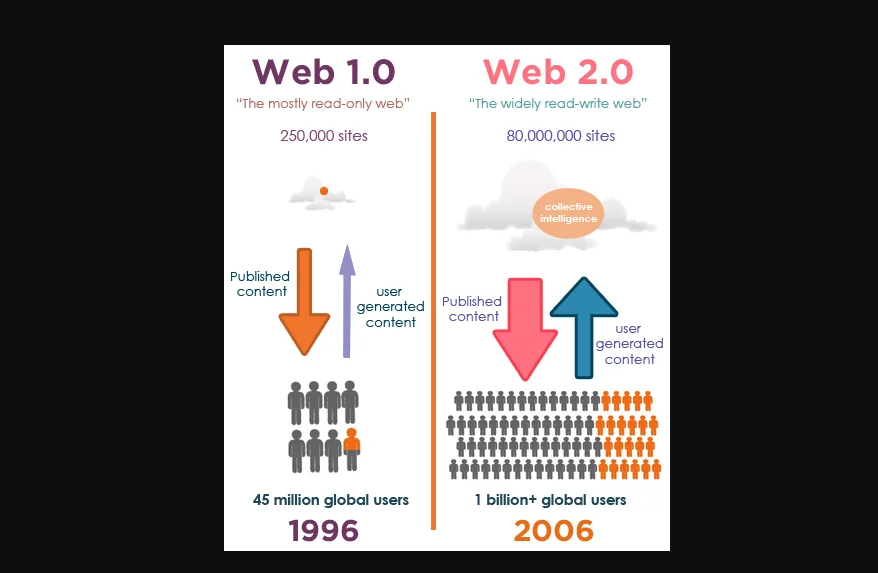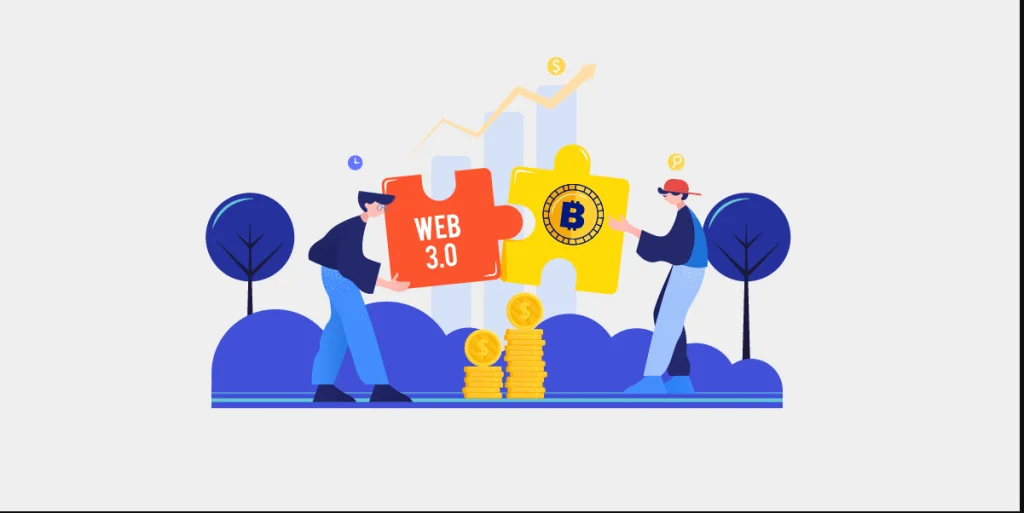Many people are confused by the online buzzword Web3 or Web 3.0 and what it’s all about.

You are a part of the modern web if you are reading this. The internet we use now is very different from what it was just ten years ago. How has the internet changed over time, and more importantly, where is it headed next? What’s more, why does any of this matter? If history has taught us anything, these shifts will have a significant impact.
Once again, we’ve arrived at a point in history when a small collection of people is attempting to remake the entire internet. This redesign, like ‘Web 2.0,’ promises to put power in the hands of ordinary people rather than large corporations.
It conjures up fantasies of a truly egalitarian web in which you and I, not Google or Facebook, have complete control over our online identities, funds, and data. However, like with any large-scale promise, Web3 must be thoroughly investigated before we can trust even its most basic notions, let alone its grandiose promises.
Web 3.0, often known as Web3, is the next edition of the World Wide Web, with a dash of cryptocurrency thrown in for good measure. Gavin Wood, the co-founder of Ethereum, coined the term Web3 in 2014, as he began to invest more in developing decentralized technologies. After considering the past versions of the internet, he came up with the moniker Web3.
How the Web evolved
The World Wide Web (www) is the principal tool used by billions of people around the world to exchange, read, and write information and communicate with others via the internet. Since its inception, the World Wide Web has progressed significantly. Here’s a quick look at how the web progressed from version 1.0 to version 2.0 and then to version 3.0.
Web 1.0
The earliest stage of the World Wide Web’s evolution is referred to as Web 1.0. In Web 1.0, there were just a few content creators, with the vast majority of users being content consumers. Personal websites were prevalent, and they mostly consisted of static pages housed on ISP-owned web servers or free web hosting services.
Advertisements on websites while surfing the internet were prohibited in Web 1.0. Ofoto was also an online digital photography website in Web 1.0, where users could store, share, view, and print digital images.
Web 1.0 is a content delivery network (CDN) that allows for the presentation of data on websites. It is suitable for usage as a personal website. It charges the user based on the number of pages viewed. It features directories that allow users to search for specific information.
Furthermore, this was the era when only text emails could be produced and delivered; no photos or pictures could be uploaded or attached. Personal pages, on the other hand, were rather prevalent, consisting primarily of static pages housed on ISP-run web servers or free web hosting services. Surprisingly, the user was charged based on the number of pages seen. It contained directories that allowed the user to search for specific information.
In a word, Web 1.0 was a content distribution network (CDN) that allowed consumers to passively receive information while being given the chance to write reviews, comments, and feedback on websites. The pages were constructed using Server Side Includes (SSI) or Common Gateway Interface, and the content was served from the server’s file system (CGI). Frames and tables were utilized to place and align the elements on a webpage back then, which is quite interesting!
Key features of Web 1.0
- Pages that are static
- The server’s file system is used to serve the content
- Pages created with Server Side Includes (SSI) or the Common Gateway Interface (CGI) (CGI)
- The items on a page are positioned and aligned using frames and tables
Web 2.0
When it comes to defining web 2.0, there are a few things to consider. The phrase refers to internet programs that allow users to share and collaborate while also allowing them to express themselves online.
It’s basically a better version of the first global web, marked by the shift from static to dynamic or user-generated content, as well as the rise of social media.
Rich web applications, web-oriented architecture, and the social web are all part of the Web 2.0 paradigm. It refers to changes in the way web pages are designed and utilized by people, without any technical changes.
Hosted services (Google Maps), Web applications (Google Docs, Flickr), video sharing sites (YouTube), wikis (MediaWiki), blogs (WordPress), social networking (Facebook), folksonomies (Delicious), microblogging (Twitter), podcasting (Podcast Alley), and content hosting services are just a few of the many Web 2.0 examples.
The main distinction between web 1.0 and web 2.0 websites is that web 2.0 websites allow users to create, share, collaborate, and communicate their work with others without requiring any web design or publishing abilities. These features were not available in the Web 1.0 environment.
Key features of Web 2.0
- Available at any time and in any location
- A wide range of media is available
- The ease with which it can be used
- Learners can actively participate in the creation of knowledge
- Can form vibrant learning group
- Everyone is both the author and the editor, and each edit can be monitored
- User-friendly
- The wiki is updated in real time, and it provides researchers with extra resources
- It allows for real-time conversation

Web 3.0
Web 3.0, also known as the executable web or read-write-execute web, is the next version of the internet. Dynamic applications, interactive services, and “machine-to-machine” interaction kicked off the trend. It’s a term that’s been used to describe a variety of web usage evolutions and interactions between different paths. In this situation, data is shared rather than owned, with multiple services providing different views for the same web/data.
Web3 Explained
Web 3.0 refers to the progression of web usage and interaction, including the conversion of the Internet into a database. It enables the web’s back-end to be upgraded after a long period of focusing on the front-end (Web 2.0 has mainly been about AJAX, tagging, and another front-end user-experience innovation). Web 3.0 is a word that is used to define several different paths of web usage and interaction. In this case, data is shared rather than owned, and different services display different perspectives of the same site/data.
The Semantic Web (3.0) claims to establish “the world’s information” in a more rational manner than Google’s current engine schema can ever do. This is especially relevant from the standpoint of machine conceptualization versus human comprehension. The Semantic Web requires the use of a declarative ontological language like OWL to create domain-specific ontologies that machines may use to reason about information and come to novel conclusions, rather than merely matching keywords.
Key features of web 3.0
Semantic Web
There is a lot of demand for new web technologies that make it easier for people to make, share, and connect content through search and analysis based on their ability to understand words, not keywords or numbers.
Artificial Intelligence
When computers combine this ability with natural language processing, in Web 3.0, they can look at information the same way humans do. This allows them to give us faster and more relevant results. They become more intelligent so that they can meet the needs of the people who use them.
Graphics in 3D
Web 3.0 has a lot of websites and services that have a three-dimensional look. 3D graphics are used in museum guides, computer games, e-commerce, geospatial contexts, and many other things, such as computer games.
Connectivity
With Web 3.0, semantic metadata makes information easier to find because it helps people find what they need. As a result, the user experience moves to a new level of connectivity that takes advantage of all the information that is out there.
Ubiquity
Content can be accessed by a lot of different apps because every device can connect to the internet. The services can be used anywhere.
Variations between Web 1.0, 2.0 and 3.0
| Web 1.0 | Web 2.0 | Web 3.0 |
| Read-Only | Read-Write | Portable and Personal |
| Company-focused | Community-focus | Individual-focus (Personalized |
| Home Pages | Blogs / Wikis | Live-streams / Waves |
| Owned Content | Content sharing | Consolidating Content |
| WebForms | Web Apps | Smart Apps |
| Directories | Tags | User Behaviour |
| Page Views | CPC | Engagement |
| Banner Ads | Interactive Ads | Behavioural Ads |
| Britannica Online | Wikipedia | Semantic Web |
| HTML/Portals | XML / RSS | RDF / RDFS / OWL |
How does Web 3.0 work?
Web 3 aspires to be a decentralized version of today’s Internet. This essentially entails handing up control of the “internet behemoths” I discussed earlier to the user. According to the Web3 Foundation, which promotes Web3 initiatives, internet users will only be able to “manage their data, identity, and future” if they adopt Web3.
So, how does it accomplish this?
Only one technology should come to mind when the term “decentralised” is mentioned: Blockchain. Web3, like other buzzwords like Bitcoin and NFTs, is built on blockchain technology. The majority of it is currently based on the Ethereum blockchain. In reality, the term Web3 was invented by Ethereum co-founder Gavin Wood in 2014. He is now the director of the Web3 Foundation.
There is no one controller of a Web3 app, also known as Decentralised Applications or dApps while building an internet on the blockchain. The way today’s websites and apps work is through their servers. Information is sent to the server and received from the server. Your online action receives a response, and only the platform provider knows what happens in the interim.
The user is often unaware of the security mechanisms in place, as well as privacy protection measures and other data-related acts. One of the reasons for Web3’s existence is to address this issue.
Web3 uses blockchain to revolutionize this procedure. For those who are unfamiliar with blockchain technology, it is a digital and distributed ledger system in which all participating systems operate as nodes. In simple terms, it is a method of storing data that employs a network of computers rather than a single computer.
Examples of Web 3.0
Although there are several instances of web 3.0 applications, we have compiled a list of some of the more popular ones.
- Bitcoin — The first cryptocurrency and has been around for almost 10 years, it is also decentralized, though not the entire ecosystem.
- Diaspora — decentralized, non-profit social network.
- Uniswap — a cryptocurrency exchange that is decentralized
- Everledger — supply chain, provenance, and authenticity platform built on the blockchain.
- Augur — decentralized exchange market.
- OpenSea — A platform for buying and selling NFTs that is built on the Ethereum blockchain.
- Steemit — blockchain-based social media and blogging platform.Sapien — a decentralized social network based on Ethereum’s blockchain.

How will Web 3.0 Impact a business?
Thanks to blockchain technology, visitors to your website will enjoy a better login experience. Consider how many times you’ve signed in to websites using your Facebook profile.
Blockchain technology employs the same principle as Facebook, which already owns your user information. The difference is that with blockchain, your data is owned only by you. Customers will be able to sign in quickly on your website, and you won’t have to worry about safeguarding their data for them since it’s already more secure.
Web 3.0 might perhaps assist to prevent hacking since blockchain technology is recognized for its stringent security standards. Due to end-to-end encryption of documents, Blockchain, according to IBM, is unlikely to be hacked. Anonymizing data and requiring authorisation to see it is another layer of protection that stops hackers from attacking your website. Companies like Apple, Google, and Facebook are already using blockchain for security.

How to be part of Web 3.0 as a developer
Blockchains are still popular, and the industry is in desperate need of engineers right now. It’s not just a lucrative field to work in, but it’s also a fascinating one. If you want to be a part of it and improve your career as a Web 3.0 developer, you’ll need to take a disciplined approach to learn.
Here’s an overview of the basic requirements for becoming a Web 3.0 developer.
Learn the fundamentals of blockchain technology: Blockchains are fantastic pieces of technology, but they aren’t easy to grasp. To comprehend what you’ll subsequently build on, you’ll need to devote some time to it.
Find out more about smart contracts: Smart contracts are the means by which the blockchain can be programmed. They are pieces of code that have been distributed to the blockchain and are written in a language that blockchain nodes can understand.
Learn how to use the Blockchain to interact with it: Your frontend and smart contracts executed on the blockchain are the two components of a decentralized app. You’ll need to interface with the blockchain in order for your frontend to communicate with it.
Master Solidity: There are a lot of blockchains out there, and almost every one of them has its own manner of creating smart contracts.
Solidity, on the other hand, is the programming language of the Ethereum virtual machine, which is used in a number of other blockchains. It won’t just help you on Ethereum. It will also assist you in the development of smart contracts on other blockchains.
Build your portfolio: Having a portfolio of previous projects might be quite beneficial in your job search. Build, build, build if you want to work in this profession.
Finally, apply for a job: now that you have all of your new skills and a portfolio, you can start looking for work.
Web 3.0 FAQ
Does Web 3.0 exist?
Web 3.0 is a futuristic innovation, with plans to be officially unveiled in 2025. It refers to the next generation of the internet, in which websites and apps will be able to handle data in a clever human-like manner using technologies such as machine learning (ML), Big Data, and decentralized ledger technology (DLT), among others. Tim Berners-Lee, the inventor of the World Wide Web, termed Web 3.0 the Semantic Web, with the goal of creating a more autonomous, intelligent, and open internet.
Is Web 3.0 the future of the internet?
Web 3.0, also known as the “future Internet,” allows consumers and developers to employ decentralized blockchain technology. To put it another way, decentralized blockchain networks enable Web 3.0 and search engines, social media platforms, and markets, among other things.
Is Web 3.0 related to Blockchain?
Only one technology should come to mind when the term “decentralised” is mentioned: Blockchain. Web3, like other buzzwords like Bitcoin and NFTs, is built on blockchain technology. The majority of it is currently based on the Ethereum blockchain. In reality, the term Web3 was invented by Ethereum co-founder Gavin Wood in 2014. He is now the director of the Web3 Foundation.
Wrapping up
We are on our way to an Internet where consumers will have complete control over their data and privacy, and will be willing to allow firms to utilize their data for marketing purposes (or not). The blockchain will be the driving force behind all of this.
As a result, web 3.0 will speed the honest and transparent use of user data across a range of applications, from tailored search results to cross-platform development tools and the utilization of 3D graphics. There will be a greater emphasis on immersion and interactivity on the web.
The upgraded Internet will be available in the near future!
